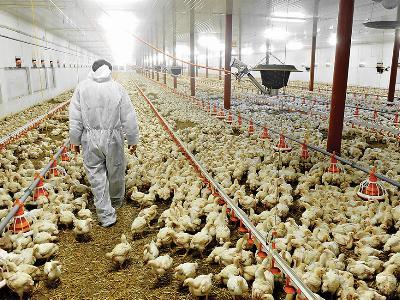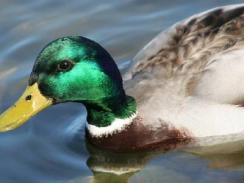Exploring limited options against broiler coccidiosis

Left untreated, broilers almost invariably suffer from subclinical infection from coccidia endemic to their environment. | roibul, Bigstock
Coccidiosis is a common, simple problem in commercial broiler production that requires a complex answer with ever-limiting options for treatment.
Coccidiosis in broilers is often left to be considered by the nutritionist, whereas most nutritionists will consider this the realm of veterinarians. In fact, it is both professions that are needed to prevent and treat this difficult and aggressive health issue that has metabolic consequences. Finding the right anticoccidial product to be included in broiler feeds should be a common decision. For example, if a flock is vaccinated against coccidia, then using an in-feed anticoccidial product can be counter-productive against the vaccine.
An easy to understand yet difficult to treat condition
Young birds are particularly susceptive to coccidiosis, caused mostly by species of the genus Eimeria, with acervulina, maxima and tenella being the most common. Bird resistance against coccidiosis in the form of complete immunity is not possible, even in older breeder birds, but some partial immunity is possible through the use of vaccines (lately) and, of course, the use of specific anticoccidial programs that involve different compounds added in feeds.
Being left untreated is not an option because coccidia, which are parasitic protozoa, are endemic in almost all poultry operations as they can live in the environment in dormant form for very long periods and can spread very easily by many means that are impossible to control. Even though most untreated flocks suffer from mild (sub-clinical) forms of coccidiosis, this invariably leads to impaired growth performance as coccidia colonize and damage the intestinal mucosa, causing impaired nutrient digestion and absorption. Clinical coccidiosis leads to high morbidity and mortality and requires heavy and long treatment to be controlled. Thus, prevention is the norm for most commercial broiler operations worldwide.
Anticoccidial options
Finding the right anticoccidial is not an easy exercise. First, coccidia rapidly develop some form of tolerance or resistance against most commercial products. To this end, different programs are proposed whereas distinct anticoccidial products are rotated or exchanged on a periodical basis. Second, most current anticoccidials are fed right below their toxic level (for the bird) and can cause significant changes in the host metabolism. Third, the current move toward antibiotic-free broiler production has reached anticoccidials (which are classed as antibiotics in the U.S. but not as such under EU regulations) leaving very few options for the prevention of coccidiosis. To this end, natural anticoccidials are sought to replace chemicals and ionophores, but their effect is never as good as existing products; the fact that existing drugs are already less than 100 percent efficient makes the use of natural anticoccidials even more difficult.
Chemicals
These are synthetic drugs that impair coccidia development once they infect birds. This action leaves an opportunity for the development of some immunity, which might be required during drug withdrawal period (if any). Their late mode of action is believed to be the primary cause of rapid resistance development by coccidia, something that has rendered most chemicals rather ineffective. To this end, some experts recommend switching to a different product every three months and not reusing the same product before 9 to 12 months have lapsed. Some veterinarians prefer to use a combination of products within a cycle to slow down the development of resistance.
Ionophores
These products of bacterial fermentation disrupt the mineral metabolism of coccidia, and they affect even the very first forms of protozoa in the gut lumen. As such, they restrict development of immunity because they do not allow coccidia to infect the animal. Although they tend to be less effective than chemical drugs (without accounting for resistance to known chemicals), they do not induce resistance, but rather tolerance. Higher dosages of ionophores can certainly overcome tolerance, but at such high levels, toxicity might become an issue for the bird as well. Ionophores should not be used for more than 6 months, with a 6 to 9 month lapse period. Again, anticoccidial programs usually entail the use of different products to prolong the effectiveness of anticoccidials.
Not all ionophores affect mineral metabolism the same way.
Natural compounds
Many existing additives have been tested as alternatives to chemicals and ionophores. Phytogenic compounds appear to be the focus of this research, but this (to kill or arrest development of coccidia) is just one of the many approaches. Another route is through the use of probiotics that make colonization harder for coccidia. Finally, improving overall animal immunity through natural immunomodulating compounds is seen as another alternative to existing anticoccidials. Lamentably, today, no single product can claim it can replace chemicals and ionophores with 100 percent efficiency, so there is some discussion whether vaccination should be reconsidered.
Metabolic considerations using anticoccidials
Anticoccidial drugs are not harmless for the bird, especially if overused. Each product has a list of known possible problems and side effects. Here, a couple well-known examples are mentioned only to illustrate the need for consulting with your nutritionist before selecting a specific product or program.
Amprolium, chemical
Although the majority of broilers are treated with ionophores, chemicals often take part in combined programs, especially for severe outbreaks. Amprolium is a well-known thiamin antagonist. Thiamin is a vitamin that is usually part of a vitamin premix, and as such it should abound in broiler diets. A thiamin degrading enzyme (thiaminase) exists in off-quality fishmeal, and the combination of both ingredients might be considered problematic. Another group of chemicals, sulfonamides being a well-known example, also affects folic acid (another vitamin) metabolism.
Monensin, ionophore
Monensin, like most ionophores, affects mineral metabolism. It has been associated with drier litter in broilers. In contrast, lasalocid, also affecting mineral metabolism, is associated with wet litter conditions. Obviously, not all ionophores affect mineral metabolism the same way. To this end, heat stress and certain products should not be combined because mineral metabolism plays a central role in dealing with thermal shock in birds.
In brief
A veterinarian should design an anticoccidial program for a specific farm, taking into account current conditions and the previous performance of birds. A profiling of the specific strains of coccidia may be required to find the correct drug or combination of drugs. Resistance and tolerance should also be taken into consideration. Nutritionists should be aware of the exact anticoccidial products being used and ensure they do not interfere with nutrient metabolism.
Có thể bạn quan tâm
Phần mềm

Phối trộn thức ăn chăn nuôi

Pha dung dịch thủy canh

Định mức cho tôm ăn

Phối trộn phân bón NPK

Xác định tỷ lệ tôm sống

Chuyển đổi đơn vị phân bón

Xác định công suất sục khí

Chuyển đổi đơn vị tôm

Tính diện tích nhà kính

Tính thể tích ao hồ




 7 tips to replace wheat for corn in…
7 tips to replace wheat for corn in…  Deciding on calcium level, source, form in layer…
Deciding on calcium level, source, form in layer…